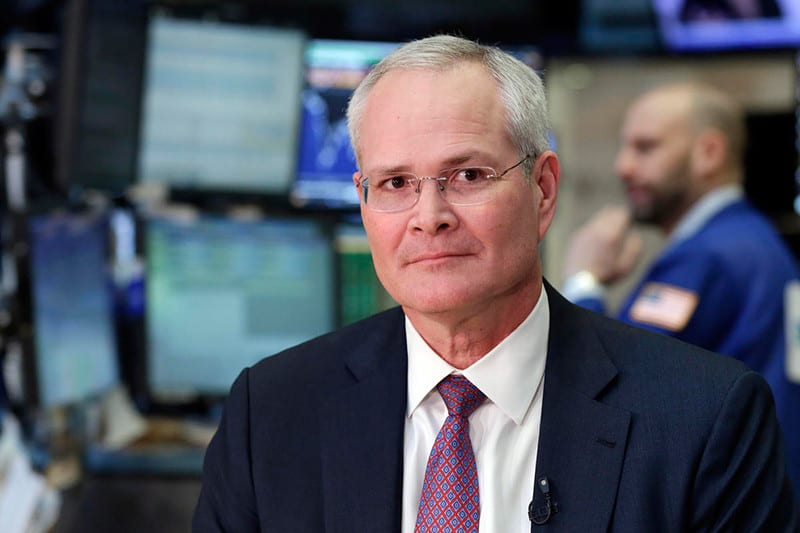(Bloomberg) — Darren Woods is mounting a strong defense of his plan to rescue ExxonMobil Corp. from its share-price slump with a multi-billion-dollar investment spree that’s at odds with the belt-tightening undertaken by rivals.
Woods’ solution, outlined in a Wednesday interview, is to invest heavily in mega-projects that he says are so low cost they’ll dominate oil and natural gas markets for decades to come. Share buybacks will come only if there’s excess cash, the chief executive officer said in an interview Wednesday, ahead of a speech on the company’s strategy at Exxon’s annual meeting on May 30.
Now his job is to persuade skeptical investors his plan will work, a hard sell so far. Since Woods’ became CEO in 2017, Exxon has fallen 9%, compared with an 18% gain for its biggest rival, Royal Dutch Shell. The CEO said he sees “a little bit of a disconnect” between the market’s short-term expectations and Exxon’s long-term planning. But he remains confident.
“Everyone, if they had the investment opportunities that we have, they would be progressing those investment opportunities,” Woods said in a broad-ranging discussion at Exxon’s Irving, Texas, headquarters. “I don’t think anybody would leave high-return projects on the table.”
Oil’s recent surge to $80/bbl has prompted competitors such as BP to buy back shares while others including Shell and Chevron have placed hard ceilings on capital expenditures as they seek to reward investors for sticking with them through the slump of 2014-2016.
Not so with Exxon. The world’s biggest publicly-traded oil company bought resources during the downturn and is now planning to spend about $200 billion through 2025 developing them.
“The thing that I won’t do is compromise these advantaged, value accretive investments to buy back shares,” Woods said. Even so, buybacks are “part of the equation,” if there’s enough cash to go around.
The Exxon leader conceded that some of the company’s past investments have weighed on returns, but insisted the future is bright. “The difference in our strategy,” he said, is “the fact that we had the confidence to work hard at developing opportunities when the broader cycle was dropping.”
In part, Exxon’s investment plan is a necessity to offset flat to falling production, which has dropped in five of the last six years. In April, the company posted its worst first-quarter production figures since the Mobil merger in 1999.
Woods puts this partly down to the company’s discipline in not investing in expensive projects when oil was selling for $100/bbl. “That led to less investment than maybe we normally would have, which when you come out of that market means you’ve got a portfolio that doesn’t have as many projects in it,” he said.
Development areas
The five key development areas — oil offshore Guyana and Brazil, liquefied natural gas in Mozambique and Papua New Guinea, and shale in the U.S.’s Permian basin — should add about 1 MMbopd by 2025. But Exxon will only grow if the additional production can withstand oil prices as low as $40/bbl, Woods said.
“If you can’t develop projects that will withstand the pressures of the price cycle you shouldn’t be doing those projects,” he said.
The investment plan, first announced in March, was met with skepticism by investors, some of whom expected Exxon to return more money to shareholders rather than boost capital spending every year from now until 2025. Since then, Woods has mounted a charm offensive, insisting this is the right moment to put money at work in projects, rather than spending it buying back shares.
Trading at a Discount
As such Exxon’s shares have struggled. After basking in a premium stock valuation for two decades, measured on a price-to-book value basis the shares last year traded at a discount to energy companies in the S&P 500 Index for the first time since 1997, according to data compiled by Bloomberg. The discount has deepened this year.
Woods, in fact, is breaking with tradition to become the first Exxon CEO to sit in on quarterly conference calls with analysts. But it’s not happening until next year. He’s planning to participate in the company’s fourth-quarter earnings call, typically in late January or early February, the company said in April.
The decision represented a seismic shift in corporate culture, as well as a bow to investors and analysts who have said they want more direct access to Woods.
Admitting that “historically we’ve had very limited interactions with the analyst community,” Woods said he and his management team have been spending more time “talking to them to understand why we’re doing what we’re doing.”
At a time when there’s much uncertainty over the future of oil and gas given the rise of renewables, electric cars and policies to curb climate change, some equity investors are reluctant to invest in Big Oil, Tim Perry, global co-head of oil and gas investment banking at Credit Suisse Group AG.
But for Exxon, oil and gas are here to stay. “If you look at oil demand in 2040, even if every light duty vehicle in the world is electric, the demand for oil is consistent with what we saw in 2013,” Woods said.



